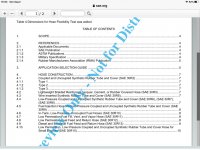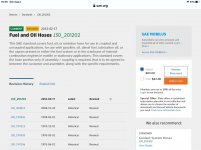142 guy
Member
- Joined
- May 31, 2014
- Location
- Saskatchewan, Canada
When I rebuilt my 142 E 6 + years ago I had used Dayco FI hose on the fuel injection system and I found that it deteriorated (cracked) very quickly. I also had a go with some Gates fuel line (I don't think it was the Barricade hose) which also was not particularly long lived. On the recommendation of another party, I tried Parker Push-on abrasion king hose and it lasted longer; but, I noticed yesterday that the supply hose to the fuel rail and return from the regulator is started to check quite a bit and the surface is getting hard. That is rather disappointing. The particular Parker hose no longer appears to be listed as a product so I am unable to confirm its temperature ratings.
I do have a chunk of Good Year Insta Grip 2G-1C-14C/33 between the rail and the regulator inlet and the exterior of that hose does appear to be in good condition, or at least much better than the Parker hose. However, I did a little checking and Good Year appears to have exited this product line with the Insta Grip being taken over by Continental. A little checking on the Continental application guides indicates that the insta grip appears to be unrated for fuel line - even though it seems to have been more durable than any of the dedicated fuel hoses that I have tried so far. Continental does sell some specific fuel line rated hoses that meet the SAE 30R9 standard which is rated to 135 C. However, there have been some interesting comments about the outside jacket of the hose getting gooey when exposed to gasoline - go figure.
Does anybody have some suggestions for fuel line? Something that is rated for use on fuel injection systems and has been in use for more than a couple of years without showing obvious deterioration? This is a D jet with an MS2 retrofit retaining all the original 5/15" barbed fittings so hose for use with AN fittings are not applicable.
I have a Honda and an Acura product and the Acura has fuel lines that are now 20 years old and showing no obvious signs of deterioration. Why do the OEMs seem to be able to source good hose and all the aftermarket stuff appears to be dodgy?
I do have a chunk of Good Year Insta Grip 2G-1C-14C/33 between the rail and the regulator inlet and the exterior of that hose does appear to be in good condition, or at least much better than the Parker hose. However, I did a little checking and Good Year appears to have exited this product line with the Insta Grip being taken over by Continental. A little checking on the Continental application guides indicates that the insta grip appears to be unrated for fuel line - even though it seems to have been more durable than any of the dedicated fuel hoses that I have tried so far. Continental does sell some specific fuel line rated hoses that meet the SAE 30R9 standard which is rated to 135 C. However, there have been some interesting comments about the outside jacket of the hose getting gooey when exposed to gasoline - go figure.
Does anybody have some suggestions for fuel line? Something that is rated for use on fuel injection systems and has been in use for more than a couple of years without showing obvious deterioration? This is a D jet with an MS2 retrofit retaining all the original 5/15" barbed fittings so hose for use with AN fittings are not applicable.
I have a Honda and an Acura product and the Acura has fuel lines that are now 20 years old and showing no obvious signs of deterioration. Why do the OEMs seem to be able to source good hose and all the aftermarket stuff appears to be dodgy?


